Today started early with
the commencement of the 2023 convention field trips. I went
downstairs to the Spotted Stag Gastropub for a breakfast of
pancakes then later walked to the hotel's north entrance and
joined the queue for our bus ride to West Palm Beach and
Brightline's Running Repair Facility tour. Buses were
schedule to start boarding at 8:00am and I was on the second
one, leaving around 8:20am.
Our trio of buses arrived
at the maintenance facility near 10:00am but there was
nobody to welcome us so we sat and waited to leave the
buses. Later we were told that members of the convention
committer were in contact with Brightline representatives
but news had not been passed to the people here at the
facility. Then the higher-ups decided that we should exit
the buses and walk around the facility with a few shop
workers answering questions from the conventioneers. We had
a full range to roam around and was probably exactly what
had been planed in the first place.
Brightline is a privately
run inter-city rail route between Miami and West Palm Beach,
Florida. Brightline began operating over its current route
in January 2018 and the company is currently building an
extension to the Orlando International Airport which is
expected to enter service in 2023.
All Aboard Florida
ordered five Siemens trainsets in 2014. Each Brightline
trainset initially consisted of four passenger coaches, with
a Siemens Charger SCB-40 diesel-electric locomotive on each
end. The coaches, with interiors designed by the LAB at
Rockwell Group, feature ergonomic seating, Wi-Fi, level
boarding and meet ADA compliance standards. Each trainset
holds 248 passengers. Working with All Aboard Florida, the
LAB also conceived the Brightline name, brand platform, and
visual identity. The entire trainset, including passenger
cars, were manufactured by Siemens in its solar-powered
plant in Florin, California. Once the route to Orlando is in
operation, the trainsets will be expanded to seven coaches,
and five more complete trainsets will be purchased. The
first of five trainsets departed the Siemens factory on
December 8, 2016, and arrived in West Palm Beach on December
14. The fifth trainset arrived in South Florida in October
2017.
The trains offers two
classes of service, with one "Select" coach and three
"Smart" coaches on each trainset. "Select" offers 2x1 and
four-to-a-table seating with 50 21-inch-wide seats per car
and complimentary snacks and beverages, while the slightly
less expensive "Smart" fare coaches seat 66 with narrower
19-inch-wide seats, with snacks and beverages available for
purchase. Each trainset is able to hold 248 passengers.
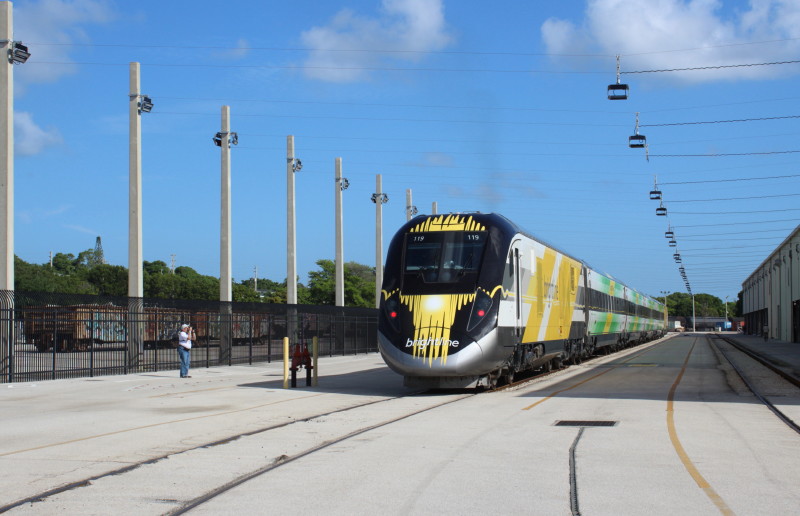
Brightline Service Green Train.





Brightline Charger SCB-40 diesel-electric 119 built by
Siemens in 2021.


Brightline Green Train Premium Service coach 1 built by
Siemens in 2021.

Brightline Green Train coach 2 built by Siemens in 2021.

Brightline Service SCB-40 diesel-electric 108 built by Siemens
in 2021.

Spare parts.


For a good look under the carriage.

Jacks to lift the cars.



Brightline Service Yellow Train with SCB-40 diesel-electric
106 built by Siemens in 2021.




Wheel lathe to turn wheels while still attached to car.


Scrap shavings.

Last look.
After everybody was back aboard and accounted for, we left for
the short trip to the town center and the Brightline station.

Looking north from the station waiting room with Florida East
Coast train at center left.
Walking into the station
at street level, you need to take the escalator up to the
waiting area. A nice young lady was standing at the
escalator collecting our tickets and while I am sure she
thought she was doing a good thing and helping, but a BIG
no-no. Our tickets had our seat number on them since It was
assigned seating, not general admission. Hint ! Never
surrender your ticket because it is your proof of purchase.
Therefore at boarding time, it was like a cattle call on the
platform or chickens with their head cut off. Strike two for
Brightline.
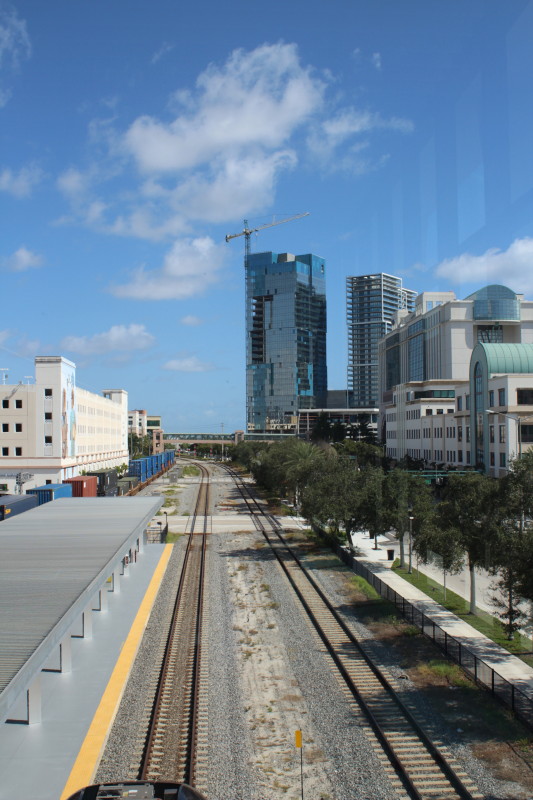

Palm Beach station waiting area for coach passengers.
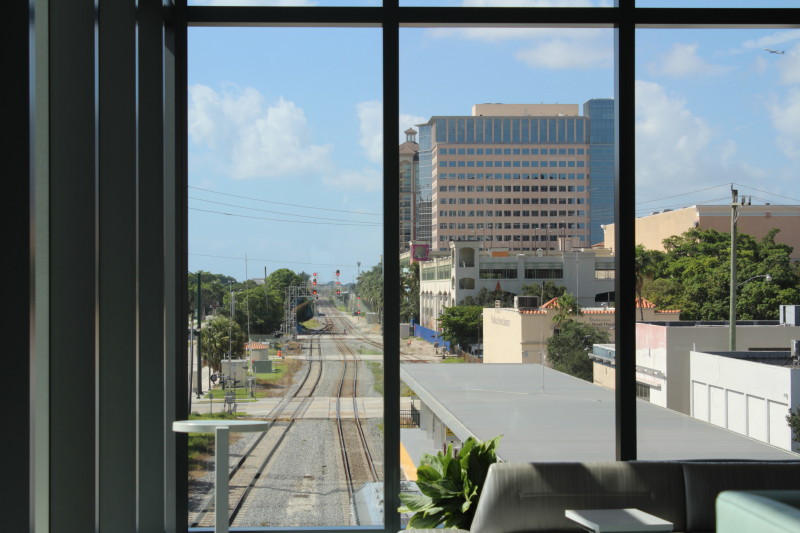
View looking south from the waiting area. Stations built
across tracks offer great train watching.


A peek into the first class waiting area.

Happy train riders.

Announcements are made on screens mounted on ceiling. Love the
glass door that opens as you approach. The restrooms are all
touch less. Nice.

Miami

More Miami.

Leaving our train in Miami.

Coach waiting area in Miami.

They like them tall down here.

First class lounge with snacks.

From the other side of the buffet table.
After exiting the train,
the conventioneers went downstairs to the waiting lounge and
our awaiting box lunches. We all raced to the boxes piled on
the table and once Elizabeth G. had taken our lunch
stubs except for about 10 or so who would be the first group
to see the operations area. Each group would rotate with the
next waiting group. After finishing my lunch, I waited for
the next group to join. Shortly, we were called for our turn
to visit the operations center.

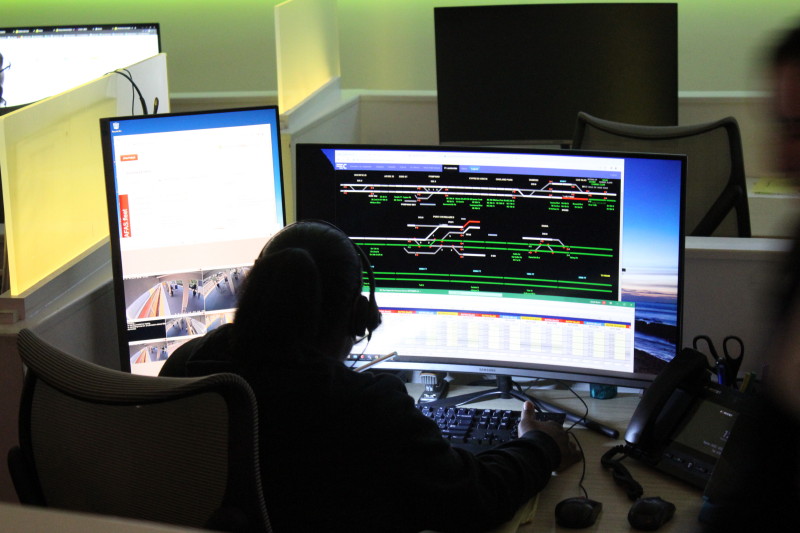
The Brightline dispatcher's screen.



The Fort Lauderdale bascule bridge that has to be in the down
position for Brightline trains to pass.


After everyone had
cycled through the operations tour, we waited for our return
train to West Palm Beach to arrive which was a few minutes
late. As a result, our train departed a bit late but we had
pleasant and problem-free return trip, arriving at West Palm
Beach at 3:05pm and proceeded to our assigned buses. After a
head count, our buses headed south to Deerfield Beach and
the Doubletree Hotel.
Epilogue
My day with Brightline
was both exciting and a learning adventure. I was able to
see and ride in the passenger cars of the future on the
Brightline. From the automatic opening of the glass doors to
the touch less restroom operations and the snack cart
traveling down the aisle, i.e. airplane style.
Brightline built new stations that are
very passenger-friendly. They are putting their money where
you can see it. As the old Hollywood mogul said to the young
producer: "Put your money up on the screen and not on fancy
cars nor expensive restaurant meals." This company is
spending big bucks and it shows. Remember, this is a freight
railroad that is going into the passenger business. Back to
the future.
The original NRHS
plan for today was to motor coach to Miami then board
the Brightline for a journey to newly-open Orlando
International Airport station. End point to end point. But
plans did not come together in time for our convention and
to Orlando did open until September 22nd. One of the route’s
choke points is the single-track bridge over the St. Lucie
River at Stuart, Fla. The U.S. Coast Guard regulation
mandated once-hourly 10 and 15-minute openings and the
railroad wanted openings only when necessary; so it was time
for plan B.
Arrangements were made to motor coach to
the Brightline Maintenance facility for a tour and then on
to West Palm Beach’s new Brightline Station and then a ride
to Miami. The tour the operations center where they dispatch
both their freight and passenger traffic was a sweet treat.
Living in Southern California, I have a
serious interest in Brightline West, the $10 billion plan to
connect the Los Angeles Basin and Las Vegas by putting a
railroad down the median of traffic-clogged Interstate 15.
The 218-mile electric railroad, with top speeds of 186 mph,
would be world class.
Plans call for the trains to whisk
passengers between Vegas and Rancho Cucamonga, California,
in 2 hours and 10 minutes, which is twice as fast as
driving. At Rancho Cucamonga passengers would be able to
connect to existing Metrolink service.
Also there is talk of linking Brightline
West with the California high-speed rail project via a new
High Desert Corridor between Victorville and Palmdale. The
state-run project is way behind schedule and massively over
budget. I have always maintained that the state should first
build a high speed rail, Los Angeles to Vegas. Get your
experience building the smaller project and then tackle the
jumbo project of Los Angeles to San Francisco.
End of Brightline
After returning to the hotel, Chris and I waited for Doug S.
to return then we walked out to his car and drove to the
lighthouse at Hillsboro Point at the Atlantic Ocean.
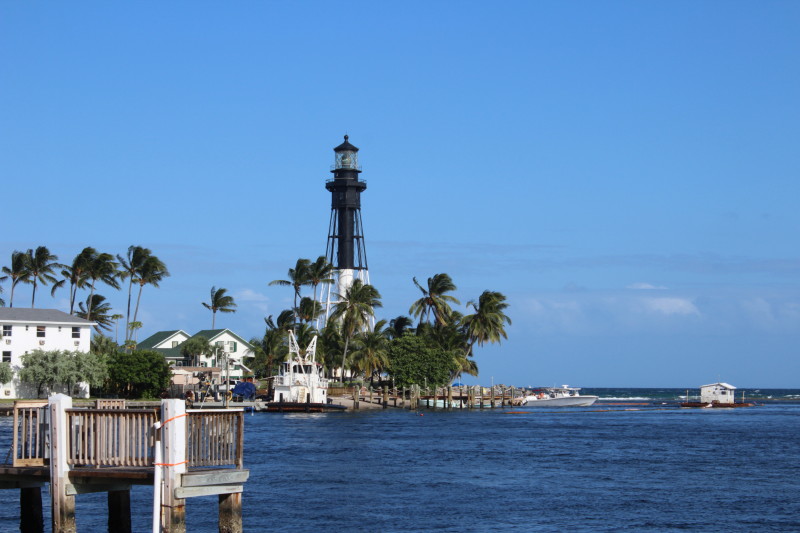
Hillsboro Inlet Lighthouse.
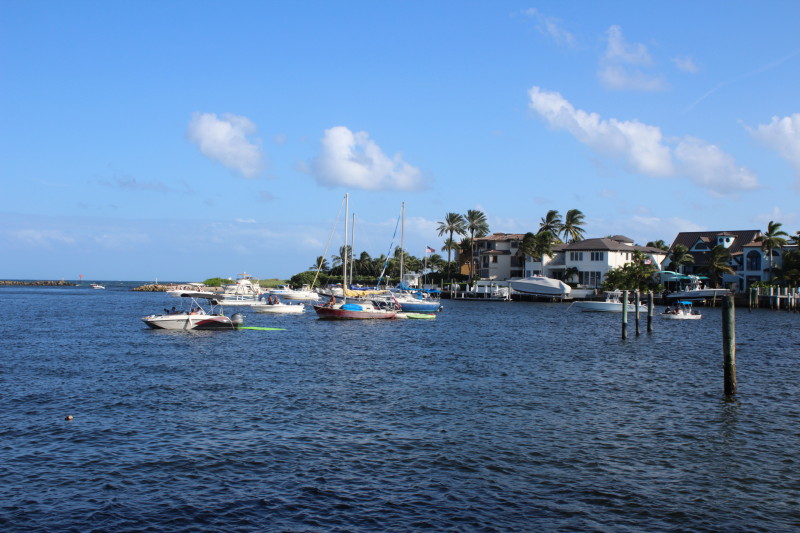
Across the bay from the lighthouse.

Hillsboro Point was
designated as hazardous for the safe navigation of ships in
1855 and federal designation was sought, with a request for
a lighthouse at the inlet was first made in 1884. The
request was repeated yearly and rejected 17 times. In 1901,
the United States Lighthouse Board persuaded Congress to
authorize the construction of a lighthouse in the dark area
between Jupiter Inlet Light and Fowey Rocks Light. The
official order approved on February 12, 1901, called for a
"first-order light at or near Hillsboro Point...at a cost
not to exceed $90,000." No appropriation of funds was made
in 1901 and in 1902 $45,000 was appropriated. The full
funding to build the lighthouse was appropriated on March 3,
1903. Initially a site on the south side of the inlet was
selected, however it was not feasible, so a site on the
north of the inlet was chosen. The owner of the property did
not want to sell at first but after beginning condemnation
proceedings, an agreement to purchase the land was reached.
The 3 acre parcel was purchased for $150 from Elnathan T.
Field and Mary W. Osborn of Middleton, New Jersey who had
bought the land for 70 cents an acre from the Trustees of
the Internal Improvement Fun.
1905
Russell Wheel and Foundry Co. of
Detroit, Michigan awarded the contract for a skeletal
lighthouse of 136 feet high to the lens room and a total
of 147 feet at its highest point.
The official description of the the
lighthouse is: 'The structure is an octagonal, pyramidal
cast iron skeleton tower with a central stair cylinder;
the lower third of the structure is painted white; the
upper two-thirds are painted black. There are three white
one-and-one-half story light-keepers dwellings in a row,
about 100 feet northward of the light tower and a red
brick oil-house stands about 50 feet to the westward of
the tower. There is also a boathouse near the inlet with
boatways 60 feet long.'
Barbier Benard et Turenne, of Paris,
France awarded contract for lens and turning mechanism.
The second order lens height is 8 feet in diameter, Rated
at 550,000 candle power for a cost not to exceed $7,250.
G.W. Brown Construction of West Palm
Beach, Florida awarded the contract to build 5 buildings
for a cost of $21,500. The buildings are: 3 houses, 1
oil-house and 1 barracks.
1906
Lighthouse is completed, inspected,
and approved for service in Detroit.
January - The lighthouse is
disassembled and shipped via Lake Erie, Lake Michigan,
Mississippi River, Gulf Mexico, around Key West, and north
to the Hillsboro Inlet - for a total of 4,000
Nautical-Miles.
The lens is shipped from Paris, France
to Miami, Florida and then north to the Hillsboro Inlet.
J.H. Gardner Construction Co. of New
Orleans, Louisiana awarded the contract for clearing the
land-laying foundation, re-assembling and erection for a
cost of $16,792.

Leaving the lighthouse,
we drove north about seven miles to Boca Raton to find the
cars at the Boca Raton station that Chris had seen earlier
this afternoon from the train returning from Miami. We found
Boca Raton easily but after driving up and down South Dixie
Highway, we had no luck in finding the ghost cars. So what
are you going to do when you are lost and confused. Why, you
call the British Spy, for sure. Shortly, Doug received a
text with the address.


Duquesne Slag Products 0-6-0T 12, nee
American Bridge Company built by Baldwin in 1930. American
Bridge was founded in 1900 by consolidation of
twenty-eight of the largest steel fabricators in the
United States. In 1902, it became a subsidiary of United
States Steel as part of the Steel Trust consolidation. In
1943, 12 was sold to the dealer Birmingham Rail &
Locomotive Company in Pittsburgh, Pennsylvania and then on
to the Duquesne Slag Products Company, where it was
renumbered 69 and was used to haul slag for concrete,
ballast, road building materials, roofing and other
industrial products.
It was donated to the Pennsylvania
Railway Museum in Scranton in 1964 and some time later,
was acquired by the Boca Raton Historical Society and
Museum. It is on display at the historic Boca Raton Rail
Depot on South Dixie Highway.



Atlantic Coast Line caboose 0771 built by the railroad in
1966.

Boca Raton Florida East
Coast station built in 1930. Historically, the station
served several long-distance trains and one or two local
trains. Into the early 1960's, passengers could take one of
two Chicago-bound trains (on alternating days), the City of
Miami or the South Wind (both via Birmingham) and the New
York City-bound East Coast Champion, Havana Special and
Miamian from the FEC's station. Into the latter 1950's,
passengers could take the Dixie Flagler to Chicago via
Atlanta from the station. The FEC operated local passenger
service between Jacksonville and the Miami area until July
31, 1968.
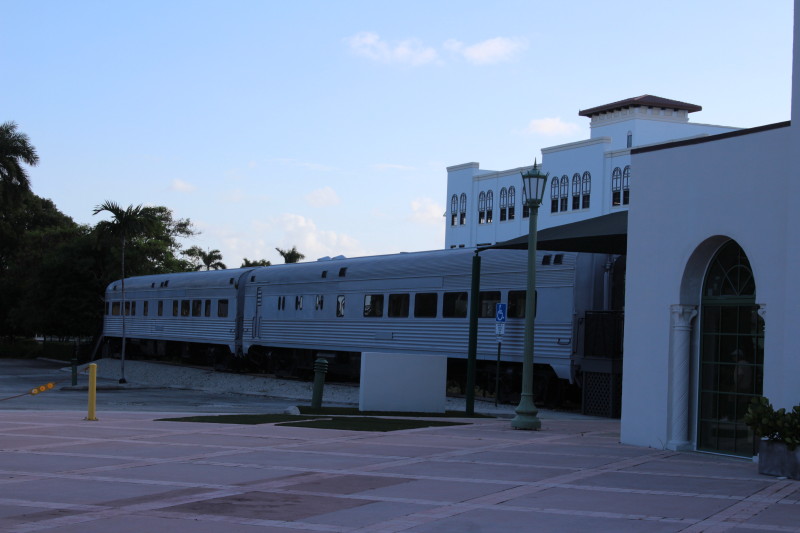
Seaboard Air Line dining car 6113 built by the Budd Company
in 1947.

Seaboard Air Line 59 seat lounge-observation car 5843,
later became 6603 "E. M. Lynn" then Amtrak 3343, built by
Budd Company in 1947. In 1983, it was sold to the Boca Raton
Historical Society.


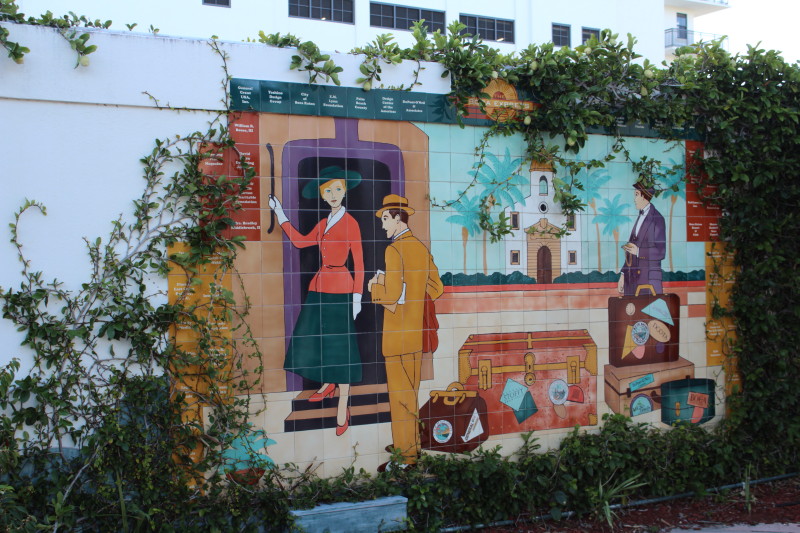
Leaving here we drove a couple of miles south to Deerfield
Beach to where we search for a caboose that Chris knew was
hiding among some trees, but where. After driving around a
park, we spotted our hidden gem.



Seaboard Coast Line caboose 0896 built by the railroad. The
three of us drove over to Jersey Mike's where Doug and I
picked up dinner (number 6 for me) and Chris bought dinner for
Elizabeth and himself . We returned to the hotel, I went to my
room to have dinner and read some emails. The end of a long
and first day of convention trips.
Thanks
for reading.
Text and Photos by Author, Robin
Bowers
The
author retains all rights. No reproductions are
allowed without the author's consent
Comments are appreciated at...
yr.mmxx@gmail.com

